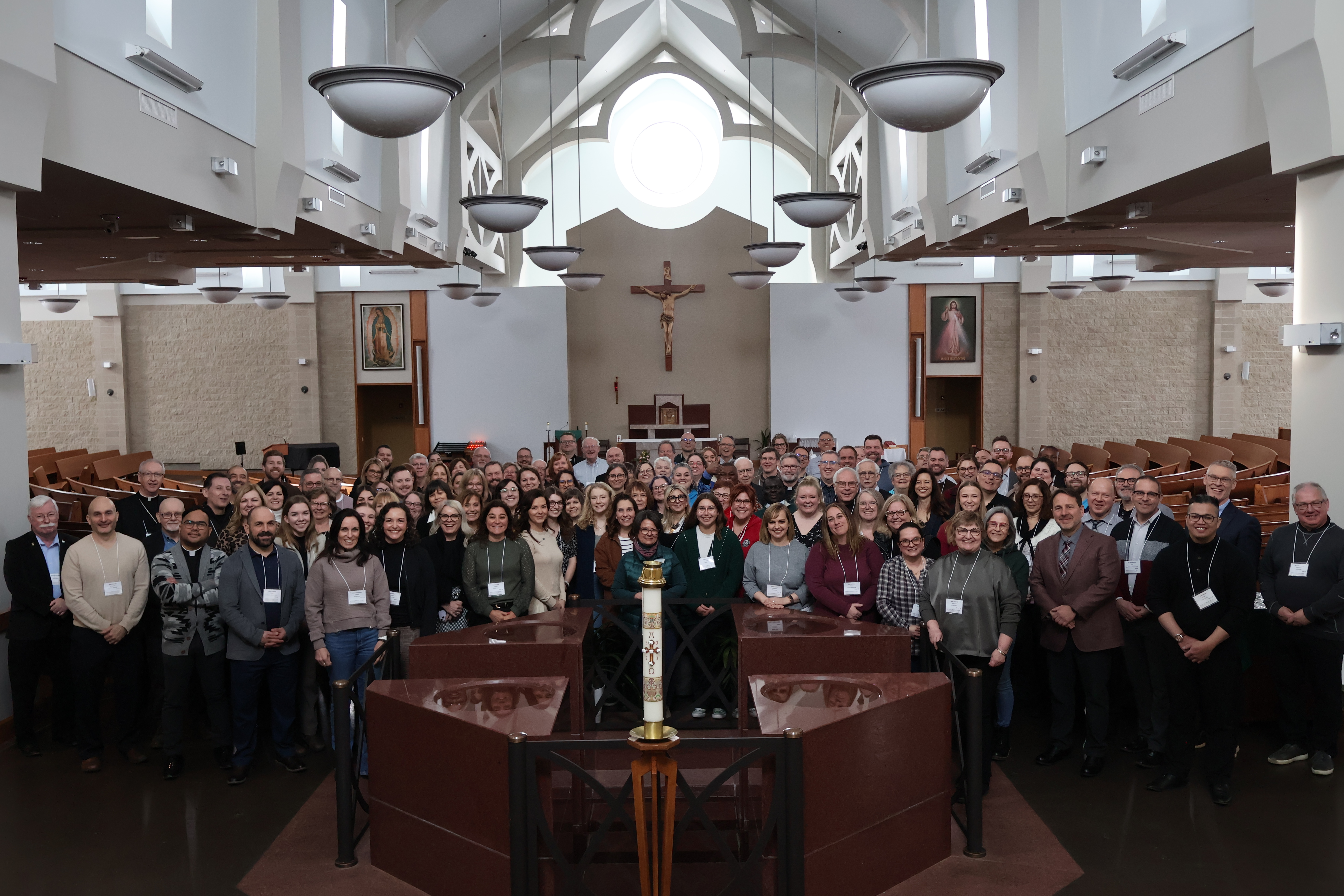The reason why the Church teaches that Catholics should send their children to Catholic schools whenever possible, and the reason why Alberta’s constitution protects the right of Catholics to have their own separate schools, is because the purpose of Catholic education is to form young people in obedience to Christ and to show how Jesus is Lord over every corner of the universe. Achieving this goal requires having a school–one where everything about that school points students towards God. The word usually used to describe this is “permeation,” though some school authorities prefer “integration.”
However, despite how commonly “permeation” appears in magisterial documents and in school policy, finding a succinct, handy definition is surprisingly difficult. This leaves a couple of important questions open:
- What exactly are we permeating?
- What exactly are we permeating it with?
Take an English class that opens and closes with the Our Father. Is this permeation? Or take a Biology class where the teacher mentions that Gregor Mendel, the founder of genetics, was an Augustinian friar. Would this qualify as permeation? One is an example of school ethos being given a Catholic aspect; the other is a bit of instructional information which makes a Catholic connection. These are two different aspects of school life into which a Catholic component has been included, though one is spiritual and one is more cerebral. So, which is it? Is permeation about infusing Catholic spirituality into the atmosphere, or about infusing Catholic content into the study materials?
Or–to put it a bit differently–suppose these are both examples of permeation. We have mentioned that, in one sense, the purpose of having Catholic schools is permeation. If the teachers include these elements, have they permeated “enough”? How much prayer is “enough” to permeate? How many Catholic-relevant facts are “enough” to include in a lesson before it is sufficiently permeated?
These are important questions because, in our secular age, the Catholic school (and the Catholic university) may be the only major avenue for generating a Catholic culture, and is probably the most important location of Catholic evangelization. Not only is Catholic formation not coming in any great measure from entertainment, media, social organizations, or government, but, sadly, it is also largely absent from Catholic homes, leaving the school as perhaps the only opportunity for the next generation to learn how to love the Lord their God with its heart, soul, mind, and strength.
(We can perhaps take comfort in the fact that this is not the first time this has happened. In the fourth century, St. John Chrysostom complained that parents took care to train their children in arts and literature but completely neglected to bring them up in the faith, and the Catholic Encyclopedia notes that it was “no longer possible for children to obtain proper religious and moral training in their own homes” is what gave rise to the monastic schools, forerunners of the Catholic schools of today.)
This culture and this formation will only develop if permeation is achieved. Therefore, let’s pay close attention to how the Magisterium uses the word in its official documents on education.
What we find is that it seems to be used in two different senses.
One use of “permeation” uses it to refer to the intentional integration of Catholicism into classrooms and explicit instruction. Since this is what it meant in its first appearance in Church teaching (paragraph 80 of the 1929 encyclical Divini Illius Magistri), we can consider this the original and primary sense of what permeation is. It is also how Vancouver Archbishop Miller uses the word when he includes it in The Five Essential Marks of Catholic Schools as the fourth mark: “Imbued With a Catholic Worldview Throughout Its Curriculum.”
However, in most of the documents from the Congregation for Catholic Education, “permeation” refers to how the entire ethos, including the relationships between staff members, should exude a Christian spirit of, as Vatican II’s Declaration on Christian Education, Gravissimum Educationis, puts it, “freedom and charity”. Now, it is obviously true that a Christian school’s atmosphere should be permeated by a sense of Christian devotion and love. However, this is also true of a parish office, a Catholic soup kitchen, or even a business with Catholic employees. There doesn’t seem to be anything specifically educational about this kind of permeation.
Moreover, when it comes to what exactly we are permeating schools with, these references are still frankly a bit nebulous. What exactly does “piety” or “the Gospel spirit” look like in a school? Won’t this look different depending on what aspect of school life is being permeated?
I think it would be helpful if we first distinguished different forms of permeation. Paragraph 2 of Gravissimum Educationis can serve as our guide. It explains the nature of Christian education this way:
“A Christian education does not merely strive for the maturing of a human person as just now described, but has as its principal purpose this goal: that the baptized, while they are gradually introduced the knowledge of the mystery of salvation, become ever more aware of the gift of Faith they have received, and that they learn in addition how to worship God the Father in spirit and truth (cf. John 4:23) especially in liturgical action, and be conformed in their personal lives according to the new man created in justice and holiness of truth (Eph. 4:22-24); also that they develop into perfect manhood, to the mature measure of the fullness of Christ (cf. Eph. 4:13) and strive for the growth of the Mystical Body; moreover, that aware of their calling, they learn not only how to bear witness to the hope that is in them (cf. Peter 3:15) but also how to help in the Christian formation of the world that takes place when natural powers viewed in the full consideration of man redeemed by Christ contribute to the good of the whole society.” (emphasis added)
We could boil this down to three major goals; or, to use curricular language, outcomes. Students at Catholic schools should graduate with:
- A deeper knowledge of the Faith
- A deeper awareness of how to worship God
- A deeper understanding of how to live in a Christian way in society
With this as a framework, I would suggest we can recognize three different forms of permeation. For mnemonic purposes, these can be categorized with three words starting with the letter “w”: worldview permeation, worship permeation, and witness permeation.
- Worldview permeation could also be called theological permeation or intellectual permeation. This refers to teaching students how to think about the universe in a way that is informed by the revelation of Jesus Christ. The teachings of the Church have implications for how history, physical science, literature, and even mathematics are interpreted. If any subject is taught without reference to God, the implication is that God is irrelevant to that subject. On the other hand, an integrated Catholic worldview will have a perspective on evolution, on artificial intelligence, on different economic systems, and on every other topic in creation, all of which are logical deductions from the Creed. The Catholic intellectual tradition should shape our entire curriculum, and students should have an integrated and coherent worldview, rather than one which professes acceptance of Christian teaching alongside total inconsistent acceptance of secular views about sexuality and society or materialist views about cosmology. This obviously requires a robust intellectual formation of teachers, and perhaps the Catholic community needs to have a serious conversation about the kind of pre-service training Catholic teachers should receive.
- Worship permeation could also be called spirituality permeation or prayer permeation. The ultimate goal of Catholic schools, and of all Catholic activity, is to know and love God. It is more important to get into heaven than college. Although salvation is by God’s grace, Catholic schools have the task of forming students so that they are open to that grace by knowing how to speak to God and how to listen to God in the way that He has revealed to us that we should. This does not just mean prayers at the beginning of class, or school liturgies–although these are indispensable. It also means that the awe students experience when learning about the beautiful intricacies of the universe should blossom into praise of its Creator. It means the stress and suffering they experience in preparing for examinations should be offered up with Christ’s suffering on the Cross. It means that breathing exercises should not be a simple internal silence but a silence that waits for God’s Word; it should be more like centering prayer than Buddhist meditation. And, when students are struggling with making decisions, they should have been taught to ask God for His guidance and to discern His will carefully (and how). Again, this should be present in every class at a Catholic school, even if it means finding or writing opening and closing prayers for a lesson that are relevant to the curriculum (“thank you, God, for creating trees”).
- Witness permeation could also be called morality permeation or praxis permeation. This refers to teaching students to live out the ethical obligations of being in communion with God. If worldview permeation relates to knowing about God, and worship permeation relates to loving God, witness permeation relates to loving one’s neighbour. This relates to both personal and communal morality. Students should learn fortitude and self-control (physical education can play an important role here) in order to master concupiscence in cooperation with grace and should be trained to be responsible and proactive citizens who use the knowledge they received from science and social studies classes to implement Catholic Social Teaching in the world. (Again, there is no subject where the behaviour of the students will be completely irrelevant. The question, “What can students do with this information?” should always be lurking, and the answer should always be some variation on “they can use it to serve God and others.”)
When teachers ask, “Have I permeated enough?”, this could be a useful checklist for them: “Have I taught my students how to interpret this information in the light of the Faith?” “Have I used what I am teaching to direct my students towards God in prayer and worship?” “Have I taught my students how they can use this content in a moral and loving way?”
Do all three forms of permeation need to be present at all times? In all likelihood, not every lesson will necessarily lend itself to this. However, it’s worth noting that, if done correctly, each form of permeation should implicitly contain the other two. Good spiritual practices and just social action should teach students to have correct theology: Lex orandi, lex credendi (“the law of prayer is the law of faith”). On the other hand, correct theology, and the breathtaking impressive scope of the Catholic intellectual tradition, should inspire students to want to adore God and to love and serve others. Orthodoxy inspires orthopraxy.
So, if this is what we are permeating with, what exactly are we permeating? Are lessons being permeated, or is the whole ethos of the school being permeated? As I mentioned, the original definition of permeation was that it had to do with curriculum. I think this has to continue to be its primary meaning. However, as every teacher knows, there are at least two kinds of curriculum: The explicit curriculum and the implicit curriculum. The explicit curriculum is what is overtly taught, but the implicit curriculum is what is indirectly taught. It is the lessons and messages the school sends to students by the way it acts, by what it treats as being important, by its general “vibe.” If a Catholic school is permeated with a Gospel spirit of freedom and charity because its staff are imitating Christ in the way they work with each other, that is itself a lesson to the students at that school about what it means to be a Christian. In that sense, all five marks of a Catholic school are a form of permeation.
Therefore, I would propose a second way of distinguishing permeation: Explicit curriculum permeation and implicit curriculum permeation. This could be another kind of checklist for teachers: Not only, “What have I taught today in my instructional activities?,” but also, “What have I taught today by my actions?” In building relationships with my students, have I modeled Christ’s love that calls on us to care even for the most difficult lost sheep (as Dorothy Day put it, “I really only love God as much as I love the person I love the least”)? In dealing with my own frustrations, have I fallen back on prayer and forgiveness in a way that models Christlikeness? In my conversations with my colleagues (and are there ever any truly private conversations at a school), have my comments not only demonstrated Christian charity but also demonstrated intellectual consistency with the Church’s understanding of what is true about the world? (As we can see, the examination of conscience has great value as a tool of professional development.)
In summary, the answer to “What is permeation?” is that, on some level, it depends. There is permeation of the implicit curriculum and of the explicit curriculum, and both should be permeated with Catholic worldview, Catholic worship, and Catholic witness. Keeping this relatively simple heuristic in mind can hopefully help Catholic teachers, and the administrators who evaluate them, ensure that they are always showing their students how to take every thought captive to the obedience of Christ (2 Corinthians 10:5).
Brett Fawcett teaches for Elk Island Catholic Schools at the Chesterton Academy of St. Isidore and is a doctoral student at the University of Calgary.










